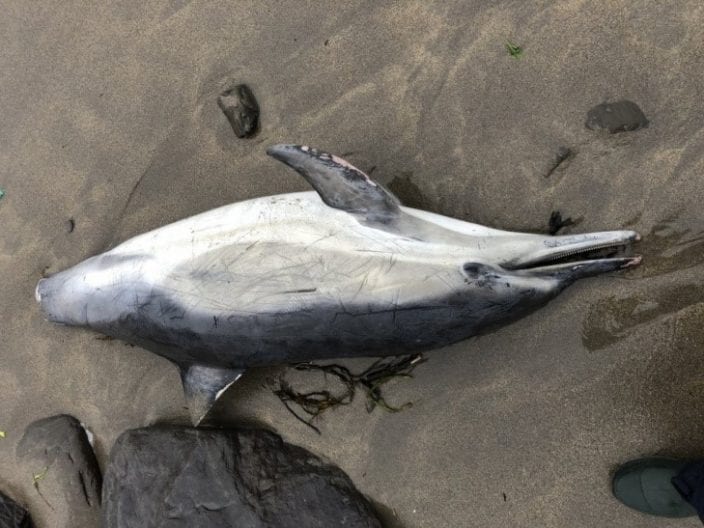IWDG Cetacean Stranding Scheme Update; January – February 2021
Since 2011, the number of strandings during the winter period has increased significantly. These strandings have been dominated by common dolphins. Here, IWDG Strandings Officer Stephanie Levesque reports on strandings during the first two months of 2021, and puts these numbers into some historical context.
Between January and February 2021, the IWDG received 93 records of stranded cetaceans comprising eight different species. As usual, the common dolphin made up the bulk of these records with 64 individuals recorded to date. Although historically the IWDG have identified January to March as a peak stranding period for common dolphins, 2021 figures are already proving to be quite high compared to the same period in previous years. This time last year, IWDG had received 70 records in total, of which 40 were common dolphins.

Photo 1. Juvenile male humpback whale stranded in West Cork on 24 Feb 2021. Photo by Helen Tilson of Schull Sea Safari.
The eight species recorded to date include common, bottlenose, striped and Risso’s dolphin, harbour porpoise, long-finned pilot whale, minke whale (Fig. 1) and one rare record of a humpback whale (Photo 1.)

Figure 1. Stranded species recorded to date: bottlenose dolphin (BND), common dolphin (CD), striped dolphin (SD), Risso’s dolphin (RD), harbour porpoise (HP), pilot whale (PW), humpback whale (HBW), minke whale (MW).
There are most likely several factors affecting this increase in reported strandings, and although we are not sure exactly what is causing it, a number of factors must be taken into account.
As the entire country found itself in lockdown, and was spending significantly more time walking the local shores during the peak stranding period, there was bound to be more reporting taking place. This is suggested by animals being found in fresher condition compared to previous years, possibly because they were being found sooner than they would have been in “normal” times. Of all cetaceans reported, 70% were classed as ‘fresh’ (Photo 2) or ‘very fresh’ (Photo 3), compared to 39% this time last year.
IWDG have had a high social media reach in recent months and perhaps more people are inclined to report these strandings.
In addition, there is increasing evidence of a broad-scale movement of common dolphins from deep offshore waters into shelf edge waters within the NE Atlantic and IWDG Sightings Officer Pádraig Whooley has noted more common dolphin sightings reported off the coast of Ireland this winter, and where you have more dolphins, it likely leads to more strandings.

Photo 2. Common dolphin carcass classed as ‘fresh’. Cromane Beach, Co. Kerry 4/2/2021. Photo by Mary Toomy.

Photo 3. Common dolphin carcass classed as ‘very fresh’. Castlegregory, Co. Kerry 6/2/2021. Photo by Liz Fitzgerald.

Photo 4. Common dolphin with tail cut off at St. Finian’s Bay, Co. Kerry 27/1/2021. Photo by Brendan McNamara.
Nine percent (9%) of reported animals have presented with gross signs of bycatch in fishing gear which include cut off tails (Photo 4), tips of dorsal fins cleanly cut, broken jaws, and the most obvious, found entangled in fishing gear. This is likely to be a minimum as diagnosing bycatch can be quite difficult if the lesions are more subtle, or drowning has taken place with no external lesions.
There is no doubt the trend with increasing common dolphin strandings identified by the IWDG in recent years is still occurring, and we must continue to monitor this going forward. Although increased reporting may also be a factor playing a contributing role, if this were the only cause, we would not expect this increase to be occurring so dramatically with just one species (common dolphin).
The Power of Citizen Scientists
On a brighter side, the IWDG have received a huge amount of reports from people all around the country, with some individual strandings being reported by over thirty different people. We would like to thank all of the citizen scientists who take the time to report to us, and urge you all to continue sending in your sightings and strandings to the IWDG.
IWDG have been recording stranded cetaceans in Ireland for the last thirty years, and our comprehensive database allows us to identify trends, such as this increase in common dolphin strandings, and help our statutory authorities to understand the causes behind them.
We would also like to thank members of the IWDG Cetacean Stranding Network and the the National Parks and Wildlife Service Conservation Rangers who visited an impressive 60% of stranding sites in order to gather additional data (length, gender etc.), as well as to collect skin samples for the Irish Cetacean Genetic Tissue Bank, maintained at the National Museum of Ireland – Natural History in Dublin. This, in addition to the many reports we continue to receive from the public, demonstrates a great level of dedication to the conservation of Ireland’s marine wildlife.
Please report your strandings at https://iwdg.ie/report-a-stranding/.
If you wish to become more involved, consider becoming a member of the IWDG Cetacean Stranding Network by contacting Stephanie Levesque at strandings@iwdg.ie.
Keep an eye out for IWDGs new Sightings and Strandings Mobile Phone Application coming soon!
Stephanie Levesque
IWDG Strandings Officer
Email: strandings@iwdg.ie


